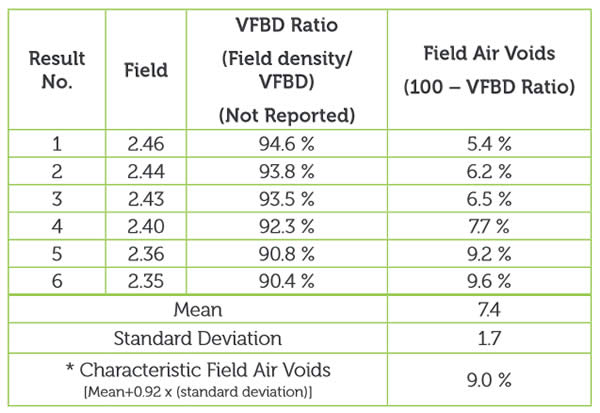Air Voids In Asphalt - Technical Note
An example of the calculation for characteristic density ratio for asphalt works is shown in Table 2, with bulk density = 2.47 t/m3
Table 2 Calculating Characteristic Density Ratio

The example shows a characteristic density ratio of 95.8%.
VOIDS FREE BULK DENSITY AND DESIGN AIR VOIDS
Voids free bulk density (VFBD) is the density of the asphalt mix without air voids. VFBD is measured in the laboratory on a sample of loose asphalt which is treated to ensure all air has been displaced. VFBD is currently required as part of asphalt mix registration for VicRoads works.
Design air voids is the ratio of the VFBD to the bulk density of the compacted asphalt mix. Design air voids can be checked in laboratory compacted mix using the following equation:
Design air voids = (VFBD – bulk density) x 100 / VFBD
An example extended from Table 2 is: VFBD = 2.60 t/m3
Design air voids = (2.60 – 2.47) x 100 / 2.60 = 5.00%
REPORTING OF FIELD AIR VOIDS
The changes to the VicRoads specification will require field density reporting to include field air voids. The reporting change requires an additional calculation, and does not change the density testing regime or the method of measurement.
Converting field density to field air voids can be accomplished in various ways. An example of the calculation for characteristic air voids is shown in Table 3 where VFBD = 2.60 t/m3 and bulk density = 2.47 t/m3
Table 3 Calculating Characteristic Field Air Voids

* Note the calculation for the characteristic value has changed.
The 9% Field Air Voids allows us to better assess the condition of the asphalt for service life.
The conversion from CDR to Characteristic Field Air Voids can be calculated using the following:
Characteristic Field Air Voids
= Design Air Voids + (100 - CDR)(bulk density/VFBD)
An example extended from Table 2 is: = 5% + (100-95.8)(2.47/2.60) = 9.0%
SPECIFICATION CHANGES
The revised specification requires both characteristic density ratio and characteristic field air voids to be reported. The regime of testing remains unchanged, and payment continues to be based on density rather than air voids.
REFERENCES
1. VicRoads, RC 500.01 Code of Practice for Registration of Bituminous Mix Designs..
2. VicRoads, Standard Section 407 – Hot Mix Asphalt.
CONTACT OFFICERS
For further information on air voids in asphalt, please contact the following officers:
Andrew Papacostas Ph: 9881 8927
Email : This email address is being protected from spambots. You need JavaScript enabled to view it.
Cassandra Simpson Ph: 9881 8928
Email : This email address is being protected from spambots. You need JavaScript enabled to view it.
Technical Consulting believes this publication to be correct at time of printing and does not accept responsibility for any consequences arising from the use of the information herein. Readers should rely on individual judgement and skill to apply information to particular issues.
- << Prev
- Next





